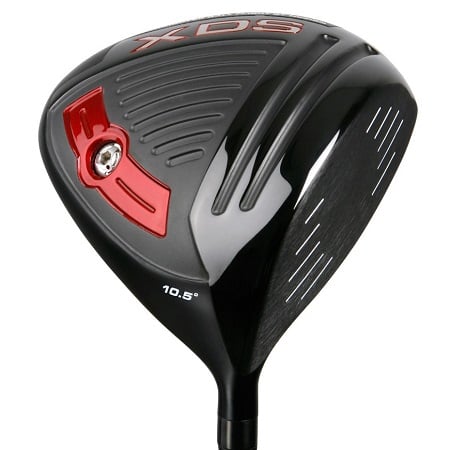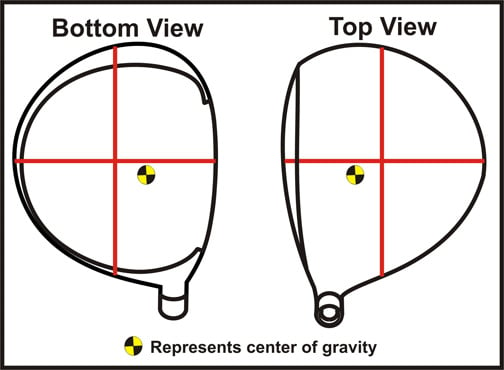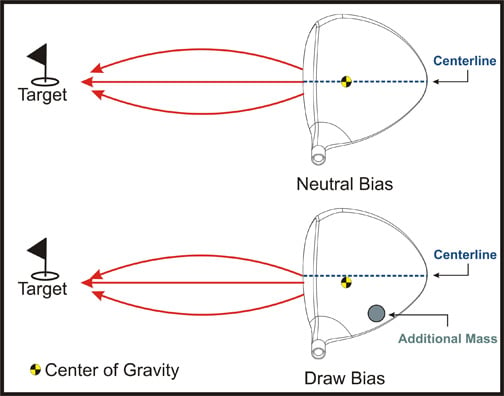“Draw Bias” Clubheads – Understanding the Principles Behind the Design Feature
Have you ever heard the term “draw bias” to describe a particular clubhead model?
Well if not, then you may want to listen up. Golfers who struggle with a fade, push or even slice should be aware of this terminology and how it could very well help you to hit the ball straighter and further. Even for those that hit the ball relatively straight may find draw biased or as I like to put it “draw enhancing” to your liking. Contrary to common belief these will not make what would normally be a straight ball flight and turn into a hook. But a draw flight will often provide more roll and overall more distance.
 Draw Biased vs. Closed Faced
Draw Biased vs. Closed Faced
One thing I should first start out by stating is that one should not confuse the difference between a closed face angle and a draw bias clubhead. Face angle is the direction the face points relative to the target. Yes, a closed face club can help start the ball far enough left (assuming a RH golfer) to correct for when the ball fades or slices. This of course assumes that the player does not compensate and open up the face at address to make it look square.
Draw bias has to deal with creating a draw spin or at least encouraging the ball to produce a draw ball flight (see diagram below). Where a golf ball ultimately lands is caused by a few factors such as how open or closed the face is at impact and the swing path of the golfer. Normally when a golf ball impacts the center of the face a draw is created by an inside/out path. For example a 2º inside/out path with a 1º closed face angle would create draw spin (like the black line in the diagram). But with a draw biased club it is possible to create a draw spin with a center impact and a square face angle and straight path toward the target line. The latter would normally produce a straight ball flight only.

Examining the CG Location of a Clubhead
 Have you ever wondered where the center of gravity of a clubhead is? Well, take a close look at a driver, fairway wood or hybrid. What you will find is the clubhead shape is very asymmetrical. Upon close inspection you may find there is a little more area on the face out toward the toe or the highest point on the crown is not in the center, but also toward the toe. Lastly, the most rear portion of the head may also be biased out toward the toe rather than the center.
Have you ever wondered where the center of gravity of a clubhead is? Well, take a close look at a driver, fairway wood or hybrid. What you will find is the clubhead shape is very asymmetrical. Upon close inspection you may find there is a little more area on the face out toward the toe or the highest point on the crown is not in the center, but also toward the toe. Lastly, the most rear portion of the head may also be biased out toward the toe rather than the center.
In the accompanying diagram there is a top and bottom view of a clubhead that has been quartered. It is amazing the center of gravity is as close to the center of the face. After all we have a heavy hosel to contend with and why the shape is often biased toward the toe area.
Draw Biased Explained
Most golfers assume the best place to hit the ball is in the center of the face and that is a valid assumption. In a neutral bias clubhead, the center of gravity will be in-line with the centerline of the face (see diagram)
When discussing the phenomenon called “gear effect”, we state that a shot struck in-line with the horizontal center of gravity would not have any side spin. However any ball struck out on the toe side of the center of gravity would create draw spin. Any ball struck on the heel side; slice spin will occur.
A draw biased clubhead is where the center of gravity is shifted toward the heel. This would true for any clubhead where the center of gravity is far enough behind the face to produce a gear effect, like in the case with drivers, fairway woods or many hybrids.
 With a draw biased head, the same scenarios occur, but the reference point changes. No longer is the centerline of the face the position where no side spin will occur. That would be toward the heel in line with the center of gravity. A shot struck in the center of the face now on the “toe side” of the center of gravity which will impart draw spin. How much draw spin will depend upon how far the center of gravity has been shifted toward the heel.
With a draw biased head, the same scenarios occur, but the reference point changes. No longer is the centerline of the face the position where no side spin will occur. That would be toward the heel in line with the center of gravity. A shot struck in the center of the face now on the “toe side” of the center of gravity which will impart draw spin. How much draw spin will depend upon how far the center of gravity has been shifted toward the heel.
Examples of Draw Biased Clubheads
There is a good chance that any driver that has been intentionally made to be draw enhancing will also be closed face, further reducing the likelihood the ball may be pushed, faded or sliced since that is what the majority of golfers do. Offset drivers and offset fairway woods can be draw enhancing by the nature of their design. Often times the longer hosel length and the extra weight required to form the offset hosel naturally shifts weight toward the heel.
There can be a strong argument that if impact not made in line with the center of gravity then some energy will be lost in the collision. True, especially if you just “nutted” one in the center of the face and you think you should be rewarded for that. But if the ball is slicing and heading towards the deep rough, tree line or worse yet – OB, then that become a moot point. This is where the aid of internal weighting and the shift in the CG is a huge benefit. Plus remember that a draw will likely produce a lower launch angle and greater run when it hits the ground which can lead to greater distance.
Examples of draw biased clubs, or draw enhancing are the Acer XDS and Acer XV Draw drivers and the Power Play Juggernaut Draw driver..

